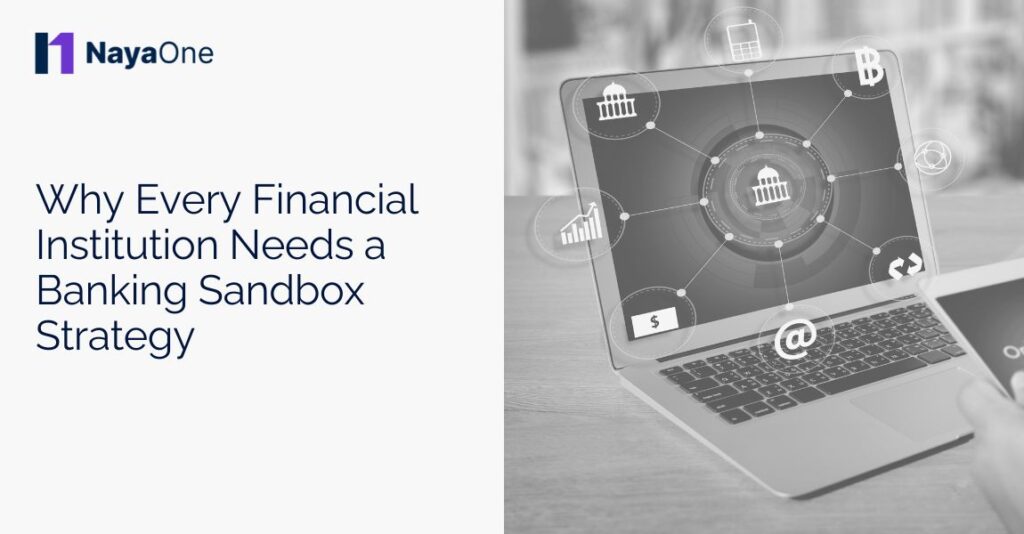Innovation in finance used to be a slow, cautious process. Big institutions would spend years designing new products, running endless tests, and making sure everything aligned with complex regulations before anyone saw the result. But that model doesn’t work anymore. Customers expect speed, convenience, and digital-first solutions. Fintechs have raised the bar, and traditional banks can no longer afford to move at a snail’s pace.
That’s where the banking sandbox comes in. Think of it as a digital playground for financial institutions, a safe space where new ideas can be tested without risking the real thing. It’s where innovation happens quickly, collaboration thrives, and creativity meets compliance. And in today’s environment, having a sandbox strategy isn’t just helpful; it’s essential.
So why exactly do financial institutions need one, and how can they make the most of it? Let’s dig in.
What exactly is a banking sandbox, and why does it matter?
A banking sandbox is a controlled testing environment that allows banks, fintechs, and regulators to trial new technologies, products, or services using real data under secure, simulated conditions. It’s a bit like a rehearsal before the big show, a place where teams can experiment, see what works, and fix what doesn’t before going live.
This concept first gained traction around the mid-2010s, driven by regulators who wanted to encourage innovation while keeping customer data and financial stability protected. Instead of shutting down new ideas for being too risky, regulators began to say, “Let’s test it safely first.”
The global fintech market was valued at USD 340.10 billion in 2024 and is projected to reach USD 394.88 billion in 2025, exhibiting a compound annual growth rate (CAGR) of 16.2% during the forecast period.
In short, a sandbox matters because it bridges two worlds: the agility of fintech innovation and the caution of traditional banking. It helps institutions find a balance between moving fast and staying secure.
How does a banking sandbox drive innovation and collaboration?
Imagine trying to build something new while being watched by a thousand auditors. That’s what innovation can feel like inside a traditional bank. There are layers of approval, tight regulations, and legacy systems that don’t always play nicely with new technology. A sandbox changes that dynamic completely.
By using a banking sandbox, institutions can create an isolated environment where teams can experiment without fear of breaking something important. They can run pilots, test integrations, and collaborate with external partners like fintech start-ups, software vendors, and data providers.
This setup opens the door to creative partnerships. Fintechs get access to the kind of infrastructure and expertise that banks have, while banks get a front-row seat to the latest digital tools and customer-focused innovations. Everyone wins.
And it’s not just about speed. Sandboxes also encourage collaboration with regulators. Instead of finding out after months of work that a product doesn’t meet compliance requirements, teams can involve regulators early in the testing process. This shared visibility reduces friction and ensures smoother approvals later.
The result? Faster innovation, better alignment, and fewer nasty surprises along the way.
What benefits do financial institutions gain from a sandbox strategy?
For many financial institutions, a sandbox strategy is the difference between reacting to market change and driving it. Here’s what makes it so powerful:
1. Reduced costs and risks
Testing in a sandbox allows teams to fail safely. Mistakes can be identified early, before money and reputation are on the line. It’s far cheaper to experiment in a simulated environment than to fix problems in a live one.
2. Faster product launches
Projects that used to take years can now move from concept to market in a matter of months. Teams can test new technologies, gather user feedback, and refine their approach before scaling up.
3. Stronger compliance and security
Because sandboxes often involve regulators from the start, compliance checks happen naturally throughout the process. This proactive approach builds trust with both regulators and customers.
4. Easier collaboration
With a sandbox in place, banks can connect with fintechs, start-ups, and even other financial institutions to co-develop new solutions. This collaborative approach helps ideas grow faster and reach wider audiences.
Take, for example, open banking initiatives across the UK and Europe. These frameworks thrive because sandboxes made it possible for banks and fintechs to exchange data securely and efficiently, ensuring innovation didn’t come at the expense of safety.
A well-designed sandbox strategy doesn’t just create better products. It creates a culture of experimentation, where teams aren’t afraid to test, learn, and adapt. And that mindset is what keeps financial institutions relevant in a fast-evolving world.
What challenges do banks face when implementing a sandbox, and how can they overcome them?
Of course, building and maintaining a sandbox environment isn’t without its challenges. Many institutions underestimate the planning and coordination required to make one effective.
Legacy systems are one of the biggest roadblocks. Older banking infrastructures weren’t built for quick integrations, which can make it tricky to connect them with modern sandbox environments. The solution lies in modular design, breaking down complex systems into manageable parts that can plug into a sandbox with ease.
Data security is another major concern. Financial institutions deal with highly sensitive information, so every sandbox needs strong encryption, access controls, and data anonymisation measures to ensure compliance.
Regulatory uncertainty can also slow things down. Not every market has clear guidelines on sandbox operations. However, this is improving rapidly as more regulators recognise the benefits of supervised experimentation.
Finally, there’s the cultural shift. For banks that have always done things by the book, encouraging teams to take risks and experiment can feel uncomfortable. Leadership support, clear frameworks, and visible success stories can go a long way in changing that mindset.
With the right strategy and the right partners, these challenges are completely manageable. The key is to treat the sandbox not as a side project but as an integral part of the bank’s long-term innovation framework.
How can financial institutions build a sustainable sandbox strategy?
The future of finance belongs to those who can test, learn, and adapt quickly. Building a sustainable sandbox strategy starts with a few simple but vital steps.
First, define clear objectives. What do you want to achieve with your sandbox: faster innovation, better compliance, or improved collaboration? Clarity ensures everyone is aligned.
Second, choose the right partners and technology. An effective sandbox should integrate seamlessly with your existing systems while providing the flexibility to explore new ones.
Third, make it part of your culture. The most successful institutions don’t just use sandboxes for one-off projects; they embed them into their innovation process.
And finally, measure success. Track performance, gather feedback, and use insights to refine the sandbox environment over time.
For companies like NayaOne, supporting financial institutions through this journey is about more than technology. It’s about creating a space where collaboration, creativity, and compliance can exist side by side. By helping banks and fintechs connect and innovate safely, digital sandbox strategies are transforming how the financial world experiments and evolves.
Because when innovation is safe, fast, and shared, the entire industry benefits, and that’s exactly what a great banking sandbox makes possible.





